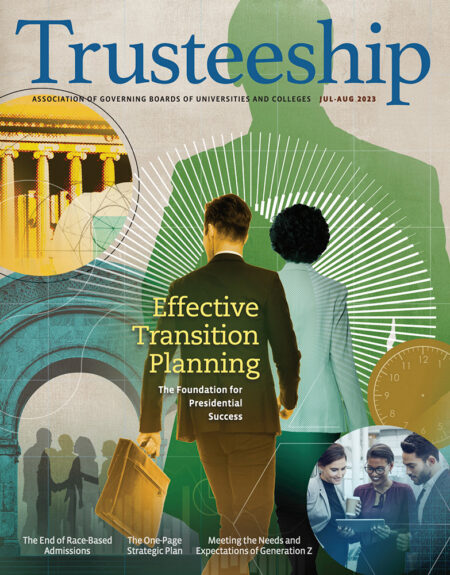
At the end of June, the Supreme Court of the United States (SCOTUS) rendered a decision in two cases affecting enrollment operations for hundreds of colleges and universities. As many observers expected, the court reversed 45 years of precedent in declaring race-based admissions unlawful. Implications are acute for boards and leaders of selective institutions; likewise, many nonselective institutions will feel effects from these decisions. The following insights are offered to help boards understand the current legal context and the important questions boards can help address.
1960s–1970s—Emergent Policies and Practices on “Affirmative Action”
- Coinciding with a period of significant social and legal activity on civil rights in the United States, Presidents Kennedy, Johnson, and Nixon each issued executive orders aimed at addressing racial bias, proliferating the language of “affirmative action.”
- Public and private colleges and universities developed their own forms of redress to historic biases against applicants for admission, including with regard to race, but largely without the benefit of model policies or broad agreement on leading practices.
1978—Regents of the University of California v. Bakke
- Petitioner Allan Bakke, a White man twice rejected for admission to the University of California Medical School at Davis, is ordered admitted. Sixteen percent of seats in each entering class had been specifically reserved for qualified racial minority applicants as part of the university’s affirmative action program, which SCOTUS determined constitutes an illegal quota.
- However, Justice Lewis F. Powell, Jr., who had cast a decisive vote, joins an additional opinion by four dissenting justices such that a majority of justices also established race as a legal consideration in admissions decisions as long as it is considered as one of several factors. That opinion also affirms the legality of shaping an ethnically diverse student body for collective educational benefit.
2003—Gratz v. Bollinger and Grutter v. Bollinger
- Both cases named Lee Bollinger, president of the University of Michigan, as respondent. In Gratz, two applicants denied admission to the University of Michigan as undergraduates filed a class-action suit alleging the admissions policy awarding a uniform number of points to applications by racial minorities violated the Equal Protection Clause of the Fourteenth Amendment, as well as the Civil Rights Act of 1964. In finding for Gratz, Chief Justice William Rehnquist wrote that the policy benefited racial minority applicants in sweeping—and thus illegal—ways.
- In Grutter, a White applicant who was denied admission to the University of Michigan Law School, Barbara Grutter, argued the school’s “critical mass” objective in assembling a racially diverse class was tantamount to a racial quota. In finding for the university, Justice Sandra Day O’Connor wrote for the majority: “In the context of its individualized inquiry into the possible diversity contributions of all applicants, the Law School’s rase-based admissions program does not unduly harm nonminority applicants.”
2013/2016—Fisher v. University of Texas at Austin
- In 1997, Texas Governor George W. Bush signed into law a guarantee of undergraduate admission to all state-funded universities for every public secondary school graduate in the academic top 10 percent of their class. It made no promises related to financial aid. Due to the racial composition of high schools in Texas, this law resulted in increased enrollment of underrepresented racial minorities in selective public universities.
- In 2013, SCOTUS initially remanded to a lower court the case brought by petitioner Abigail Fisher, a White person who alleged she had been harmed by Texas’ Top Ten Percent Rule in being denied admission to the University of Texas at Austin. In 2016, the case returned before SCOTUS. A narrow majority decided the law was appropriately narrowly tailored to serve a compelling state interest in crafting diverse student bodies in public universities and did not constitute an illegal quota system.
2023—Students for Fair Admissions v. President and Fellows of Harvard & Students for Fair Admissions v. University of North Carolina
- Students for Fair Admissions (SFFA) is a nonprofit organization created to facilitate state and federal anti-affirmative lawsuits against universities, including the earlier Fisher suits. In these cases, it sought legal relief on behalf of unspecified individuals (Asian-American and White applicants) allegedly harmed by rase-based admissions policies at Harvard and UNC. By using race as a “plus factor” in admissions decisions, SFFA asserted, the universities have effectively penalized applicants of nonpreferred races. Note: the person who established Students for Fair Admissions has also incorporated the Alliance for Fair Board Recruitment, which facilitates lawsuits to “promote the recruitment of corporate board members without regard to race, ethnicity, sex, and sexual identity.” Whether future suits brought by this group may impact higher education governing boards is unclear.
- Writing for the majority in a single decision for both cases, Chief Justice John Roberts stated: “Both programs lack sufficiently focused and measurable objectives warranting the use of race, unavoidably employ race in a negative manner, involve racial stereotyping, and lack meaningful endpoints.” He further noted that the Court’s decision does not prohibit consideration of an applicant’s “discussion of how race affected his or her life, be it through discrimination, inspiration, or otherwise.” However, he added, institutions may not ask students to reflect specifically on racial experiences, such as in an essay, to impermissibly discern and consider racial identity.
Suggested questions for boards of selective colleges and universities:
- Should we expect fewer racial minority applicants going forward, and how would that affect our overall selectivity, academic profile, reputation, and net student revenue?
- For institutions seeking to maintain or attain federal recognition as Hispanic-serving, how has the outlook for success changed?
- SCOTUS decisions continue to affirm that racial and ethnic diversity carries a compelling educational benefit. If we were to experience a decrease in underrepresented minority enrollments, similar to selective public universities affected by state-level affirmative action bans, how would it affect the quality of education here?
- How has our campus community received news of the court’s decision, what has been communicated by leadership to date, and what should be done this fall to respond and address constituent concerns?
- Which policies and practices do we have that result in overrepresentation of White students, and what might be done to mitigate any unintended or undesired effects?
- Boards are ultimately accountable for production of qualified graduates, not just enrollment; data show White or Asian-American college students remain significantly more likely to complete bachelor’s degrees nationally, and in many contexts fewer than half of all Black or LatinX students complete them. How is our institution performing when it comes to degree completion rates, and to what extent might a change in racial composition of our student body affect the urgency with which we need to address any achievement gaps?
Suggested questions for boards of nonselective colleges and universities:
- Should we expect an increase in applications from racial minorities, and are we prepared to serve these students well?
- What can we do to ensure students who might otherwise have enrolled in more selective institutions (i.e., “undermatching”) thrive here?
- How might we make the most of a potential enrollment increase to grow our reputation, resources, and impact?
Andrew Lounder, Ph.D., is associate vice president of programs for AGB.
RELATED RESOURCES

AGB Policy Alert
Supreme Court Rules Race-Based Admissions Unconstitutional

Webinar On Demand
The End of Race-Based Admissions: Important Considerations for Boards

Reports and Statements
Top Public Policy Issues Facing Governing Boards in 2023–2024

